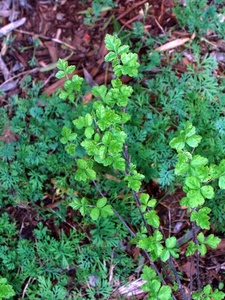Sumacs are members of the cashew family (Anacardiaceae). This family includes pistache trees, pepper trees, and Poison Oak, as well as the smaller and less well-known species on this page. Tree of Heaven is also sometimes described as a sumac; it is in the simarouba family rather than the cashew family, but the two families are closely related.
Sumac species are a major cause of hay fever. They typically bloom from about March through June, so if you suffer from hay fever during those months, a sumac could be the culprit.
Native to Yolo County
 Fragrant Sumac (Rhus aromatica) in a garden. Photo by queerbychoice.Fragrant Sumac (Rhus aromatica) is a deciduous shrub native to the Yolo County foothills, including the Capay Hills. It usually grows 2 to 8 feet tall and 5 to 8 feet wide. It prefers full sun. It has low water needs. It bears a strong visual resemblance to Poison Oak, having similar three-leaflet clusters. It does produce trace amounts of urushiol, the hyperallergenic oil produced by Poison Oak; however, the quantity of urushiol produced by Fragrant Sumac is comparable to the quantity you could be exposed to by touching mangoes (which also contain urushiol) from the grocery store. Fragrant Sumac can be distinguished from Poison Oak by the way in which the leaflets attach to the branch: in Poison Oak, the central leaflet in each cluster is attached by a small leafstalk, whereas Fragrant Sumac leaflets always attach to the branch directly, without a leafstalk. Fragrant Sumac plants are either mostly male or mostly female; each plant has primarily either male or female flowers but also a few flowers of the other sex and/or a few “perfect” flowers (containing both male and female parts in the same flower). The mostly male plants are ranked 10 out of 10 on the Ogren Plant Allergy Scale, indicating that they tend to cause very severe hay fever. Although female flowers cannot produce pollen, even the mostly female plants are ranked 7 out of 10 on the Ogren Plant Allergy Scale, due to the potential for allergic reactions to contact with these plants or with smoke produced by burning these plants.
Fragrant Sumac (Rhus aromatica) in a garden. Photo by queerbychoice.Fragrant Sumac (Rhus aromatica) is a deciduous shrub native to the Yolo County foothills, including the Capay Hills. It usually grows 2 to 8 feet tall and 5 to 8 feet wide. It prefers full sun. It has low water needs. It bears a strong visual resemblance to Poison Oak, having similar three-leaflet clusters. It does produce trace amounts of urushiol, the hyperallergenic oil produced by Poison Oak; however, the quantity of urushiol produced by Fragrant Sumac is comparable to the quantity you could be exposed to by touching mangoes (which also contain urushiol) from the grocery store. Fragrant Sumac can be distinguished from Poison Oak by the way in which the leaflets attach to the branch: in Poison Oak, the central leaflet in each cluster is attached by a small leafstalk, whereas Fragrant Sumac leaflets always attach to the branch directly, without a leafstalk. Fragrant Sumac plants are either mostly male or mostly female; each plant has primarily either male or female flowers but also a few flowers of the other sex and/or a few “perfect” flowers (containing both male and female parts in the same flower). The mostly male plants are ranked 10 out of 10 on the Ogren Plant Allergy Scale, indicating that they tend to cause very severe hay fever. Although female flowers cannot produce pollen, even the mostly female plants are ranked 7 out of 10 on the Ogren Plant Allergy Scale, due to the potential for allergic reactions to contact with these plants or with smoke produced by burning these plants.
 African Sumac (Searsia lancea) at the end of Teton Place in Wayne Cline Park. Photo by queerbychoice.African Sumac (Searsia lancea), also called Karee, is an evergreen tree from southern Africa. It can grow to 25 feet tall and 15 feet wide. African Sumac trees are either male, mostly male, female, or mostly female; each tree has primarily either male or female flowers but may also have a few flowers of the other sex and/or a few “perfect” flowers (containing both male and female parts in the same flower). The male or mostly male trees are ranked 10 out of 10 on the Ogren Plant Allergy Scale, indicating that they tend to cause very severe hay fever. Although female flowers cannot produce pollen, even the female or mostly female trees are ranked 7 out of 10 on the Ogren Plant Allergy Scale, due to the potential for allergic reactions to contact with these plants or with smoke produced by burning these plants. African Sumac is planted at Dave Douglass Park and Wayne Cline Park. It is also planted as a street tree on West Kentucky Avenue.
African Sumac (Searsia lancea) at the end of Teton Place in Wayne Cline Park. Photo by queerbychoice.African Sumac (Searsia lancea), also called Karee, is an evergreen tree from southern Africa. It can grow to 25 feet tall and 15 feet wide. African Sumac trees are either male, mostly male, female, or mostly female; each tree has primarily either male or female flowers but may also have a few flowers of the other sex and/or a few “perfect” flowers (containing both male and female parts in the same flower). The male or mostly male trees are ranked 10 out of 10 on the Ogren Plant Allergy Scale, indicating that they tend to cause very severe hay fever. Although female flowers cannot produce pollen, even the female or mostly female trees are ranked 7 out of 10 on the Ogren Plant Allergy Scale, due to the potential for allergic reactions to contact with these plants or with smoke produced by burning these plants. African Sumac is planted at Dave Douglass Park and Wayne Cline Park. It is also planted as a street tree on West Kentucky Avenue.
Links


